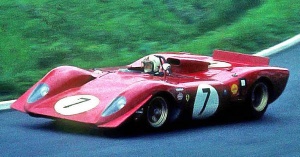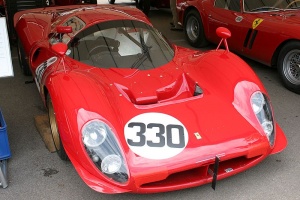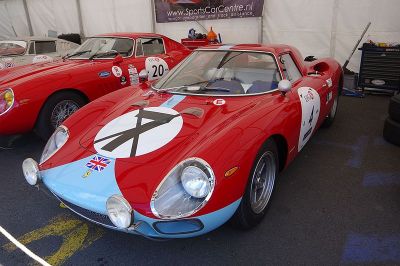Ferrari 250 LM
Although Enzo Ferrari resisted the move for road use, Ferrari began producing mid-engined racing cars in 1963. Although these cars shared their names (based on engine displacement) with road models, they were almost entirely dissimilar. The first mid-engined Ferrari road car did not arrive until the 1967 Dino, and it was 1971 before a Ferrari V12 was placed behind a road-going driver in the 365 GT4 BB.
250 P
The 250 P racer was almost entirely unrelated to the other 250 cars. It was a mid-engined sports car racer with a 250 Testa Rossa V12 engine. The car was produced in 1963 and won the 12 Hours of Sebring, 24 Hours of Le Mans, and the manufacturers' championship.
250 LM
At the November 1963 Paris Auto Show, Ferrari introduced the 250 LM (Le Mans). It was developed as a coupé version of the 250 P and was ostensibly a new production car intended to meet FIA homologation requirements for the Group 3 GT class. The intention was for the 250 LM to replace the 250 GTO as Ferrari's premier GT-class racer. However, in April 1964 the FIA refused to homologate the model, as Ferrari had built considerably fewer than the required 100 units. The 250 LM thus had to run in the prototype class until it was homologated as a Group 4 Sports Car for the 1966 season.
32 total 250 LM chassis were built from 1963 to 1965, with all but the first chassis (s/n 5149, the Paris Auto Show car with a 250 P engine) powered by 3.3-liter 320 bhp (238 kW) engines as used in the 275 P. According to Ferrari naming convention, the 3.3 litre cars should have been designated "275 LM", however Enzo Ferrari insisted that the name remain 250 LM in order to facilitate the homologation process. The 250 LM shared fully independent double wishbone suspension, rack and pinion steering, four wheel disc brakes and 5-speed transaxle with the 250 P, however the tubular space frame chassis was significantly strengthened with the roof structure, additional cross-bracing and heavier gauge tubing. The interior was trimmed out as a nod to the ostensible production status of the car, but ultimately it was little different from a prototype racer.
The 250 LM was successfully raced around the world by both factory-supported and privateer racers. Unlike the 250/275/330 P cars, new 250 LMs were sold to private customers and campaigned by privateer teams. From 1964 through 1967, 250 LMs were raced by Scuderia Ferrari, NART, Maranello Concessionaires, Ecurie Filipinetti, Ecurie Francorchamps and others, even when this model was no longer competitive with the latest factory prototypes. Notably, a 250 LM (chassis 5893) entered by the North American Racing Team won the 1965 24 Hours of Le Mans driven by Jochen Rindt and Masten Gregory. This remains Ferrari's last overall victory in the endurance classic. This car is now owned by the Indianapolis Motor Speedway Museum and was displayed at the 2004 Pebble Beach Concours d'Elegance and the 2013 Amelia Island Concours d'Elegance.
The 250 LM is highly sought-after by serious auto collectors and individual cars are often featured at auctions, car shows and historic racing events. 250 LMs typically sell for more than $10 million USD and auction records for this model have been repeatedly broken in the past 10 years.
275 P and 330 P
For the 1964 season, Ferrari developed the 275 P and 330 P. These were improved versions of the 250 P with larger displacement engines and slightly modified bodywork. The tubular space-frame chassis and most other components remained the same as in the 250 P. The 275 P used a bored-out 3.3L version of the 250 Testa Rossa-type engine originally utilized by the 250 P. The 330 P used a different design, a 4.0L Colombo-designed V12 based on engines used in the 400 Superamerica road cars. The 330 P developed more power than the 275 P (370 bhp vs 320 bhp) but weighed more (785 kg vs 755 kg). Some drivers preferred the extra power of the 330 P while others appreciated the more nimble feel of the 275 P and the two models were raced concurrently. Production of these types included three brand new chassis and conversions of all four 250 P chassis. It is not possible to clearly determine the number of chassis produced with each engine type as 275 and 330 engines were swapped as needed between cars. 275 P and 330 P cars were actively and successfully raced by Scuderia Ferrari, NART and Maranello Concessionaires during 1964 and 1965 seasons. The most notable result was a 1-2-3 sweep at the 1964 24 Hours of Le Mans. The Scuderia Ferrari-run 275 P driven by Guichet and Vaccarella took first, followed by a Maranello Concessionaires 330 P (Hill/Bonnier) in second and a Scuderia Ferrari 330 P (Bandini/Surtees) in third.
330 P
The 250 P was stretched in 1964 to accept the 4.0 L 330 engine, becoming the 330 P.
330 P2
An entirely new car, the 330 P2, followed in 1965. It was first used by Luigi Chinetti's North American Racing Team (NART) at Daytona that year. It was powered by a 410 hp (305 kW) version of the 330 V12.
330 P3
The 1966 330 P3 introduced fuel injection to the Ferrari stable. It used a P3 (Type 593) transmission whose gears were prone to failure.
There are no longer any Ferrari P3s extant as the original P3 0846 was converted to a P3/P4 and definitively written off and scrapped by Ferrari due to previous accident damage and fire damage it sustained at Le Mans 1967, and P3s 0844 and 0848 were converted to P3/412 Ps by Ferrari. At a later point P3/412P 0844 was converted by Ferrari to a 330 Can-Am and in the 1990s returned to P3/412P configuration in private ownership.
330 P4
1967 was a banner year for the Enzo Ferrari motor company, as it saw the production of the mid-engined 330 P4, a V12-engined endurance car intended to replace the previous year's 330 P3. Only four Ferrari P4-engined cars were ever made: three new 330 P4s and one ex P3 chassis (0846). Their three-valve cylinder head was modeled after those of Italian Grand Prix-winning Formula One cars. To this was added the same fuel injection system from the P3 for an output of up to 450 hp (335 kW).
The P3 won the 1000 km Monza in 1966, and the P4 won the same race in 1967. Two P4s, and one 412 P crossed the finish line together (in first 0846, second 0856, and third place 0844) in the 1967 24 Hours of Daytona, for a photo finish to counter Ford's photo of the Ford GT40 Mk.II crossing the finish line together First, Second, and Third at the 1966 24 Hours of Le Mans.
Since then, the fate of these four cars has been the subject of much attention.
- 0846. Built in 1966 as the first of 3 works 330 P3s and the only P3 Spyder. Retained by the works at the end of 1966 and used as the basis for the new P4 and partially converted to P4 specification for 1967. Ferrari states 0846 no longer exists. It was decided by the factory to scrap the chassis due to its previous accident history and fire damage sustained at Le Mans, 1967. The original chassis number has been written off Ferrari's books as an existing chassis, but the number is still in their ownership. Template:Fact
- 0856 was originally built as a Berlinetta but converted by the factory into a Spyder for Brands Hatch, 1967 as it remains today. Currently owned by Lawrence Stroll.
- 0858 was originally a Berlinetta but converted by Ferrari into a Spyder for Brands Hatch, 1967 and later in the year converted into a 350 Can-Am by them. Now fitted with a P4 Berlinetta body and is in German ownership.
- 0860 was also originally a Berlinetta and converted to a Spyder for Brands Hatch, 1967 and like 0858 converted by Ferrari to a 350 Can-Am but was fitted with a P4 Spyder body in the early 1970s by its then French owner in whose family it remains today.
312 P

After boycotting sports car racing in 1968 to protest the rule change, Ferrari built another 3000cc prototype in 1968, named the 312 P.
The 3.0 Ferrari 312P Barchetta and 3.0 Ferrari 312P Berlinetta were hardly more than 3-litre F1 Ferrari 312s with prototype bodies. At the 12 Hours of Sebring the spyder finished second to a JWA Gulf Ford GT40. At the BOAC 500 at Brands Hatch the same spyder was fourth behind three Porsche 908-01s. At 1000km Monza, Chris Amon took the pole with the 312P spyder, ahead of Jo Siffert's 908-01, but had to retire. At the 1000km Spa, a 312P was second, behind the Siffert-Redman 908-01LH. At Le Mans two 312P Berlinettas were entered. They were five and six on the grid, but did not finish. At the end of the season the 312Ps were sold to NART, the American Ferrari importer of Luigi Chinetti.
Three 312 Ps were built:
0868 Spyder configuration, dismantled after Monza accident
0870 Berlinetta configuration in Bardinon Collection
0872 Berlinetta configuration (and Spyder body available) in Switzerland
312 P (1971-1973)
In 1971, another rule change was announced for 1972, and Ferrari abandoned further development of the 512M in order to focus on a new 3 Litre prototype based on the 312B F1 car. The 312P would prove fast but fragile in its debut at the 1971 Sebring 12 hours. Further development over the 1971 season brought increased reliability. The press added a "B" to 312P. Ferrari official records: Ferrari 312 P.
The 312Ps with the flat-12 boxer engine were very successful, winning ten out of eleven races in the 1972 World Championship for Makes and delivering the title to Ferrari. Scuderia Ferrari didn't enter the 1972 24 Hours of Le Mans, as Enzo Ferrari thought that the F1-based engine could not last the full 24 hours. He would be proven wrong.
The team competed in the 1973 24 Hours of Le Mans and finished second behind Matra, which would also be the teams' final standing in the 1973 championship. At the end of the 1973 season, Ferrari was forced by chief investor FIAT to abandon sports car racing, instead focusing on F1.
412 P

The Ferrari 412 P was a "customer version" of the famous 330 P3 race car, built for independent teams like NART (0844), Scuderia Filipinetti (0848), Francorchamps (0850), and Maranello Concessionaires (0854). These cars had carburetor engines instead of the factory Lucas fuel injection. Surviving 412 P cars are worth approximately $35–45 million USD according to Cavallino Magazines' current Buyers Guide.
There are only two cars that were originally built as 412 Ps: 0850 and 0854. P3 chassis. P3 Typo Motors except for Carburetors in place of FI. P4 suspension 0844 and 0848 were originally P3 Factory Racecars but when Ferrari sold them to customers they removed the Lucas Mechanical Fuel Injection and replaced it with Weber carburetors which reduced their output, something Ferrari wanted to do so that they would win points but not beat the factory cars which were then P4 0846 (See Above), P4 0856, P4 0858, and P4 0860. The P3's and 412 P had the same 4-liter block which is different from the P4-4 liter block and all had P3 not P4 chassis. All the P3 chassis were made in 1966 at the same time but because of labor strikes only three of the five P3 chassis were built up into cars in 66. The unbuilt up P3 chassis were eventually build up into 412P 0850 and 0854 in 1967. P4 0846 was unique having, after modification by Ferrari for the 1967 race season, a P3 chassis with a P4 engine.
The 412 P and P4 models weren't eligible for the International Championship of Makes in 1968 as their engines were too large for the new 3 liter Group 6 Prototype category and too few examples had been built to allow homologation for the 5 liter Group 4 Sports Car category which required production of at least 50 units.[30] Ferrari did not contest the championship for a year in protest.
Two 412 P Berlinettas were originally built. Two P3's were converted to 412P's by Ferrari:
0844 Originally a works Berlinetta was converted by Ferrari from a P3 to into a customer concessionaires P3/412 P, then by Ferrari and NART to an open barchetta 330 Can Am, and is currently in Germany fitted with a Berlinetta 412 P body. 0848 Originally a works Berlinetta was converted by Ferrari from a P3 to a customer concessionaires P3/412 P and is currently in Switzerland. 0850 Originally a customer concessionaires Berlinetta, was at one time, in private ownership, converted for road use as a spider but was later refitted with a Berlinetta body and is currently owned by an American. Ferrari Classiche restoration completed in 2017. 0854 Originally a customer concessionaires Berlinetta, in private ownership was heavily burned out and "virtually destroyed" at a race in East London, S.A. 1969 when it had an open/barchetta GRP body fitted to it by modifying and cutting the rear of chassis. The remains were rebuilt, again as an open barchetta and then further rebuilt into a 412P esque Spider and used on the road. It has now been returned to Berlinetta configuration using the original front and rear clips and doors but the main center part of the body, roof and sills have been remade in the US where it is owned.


